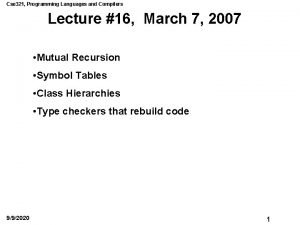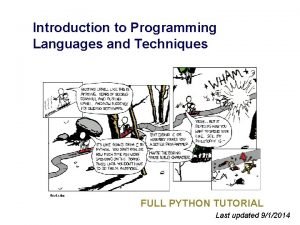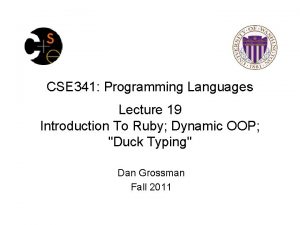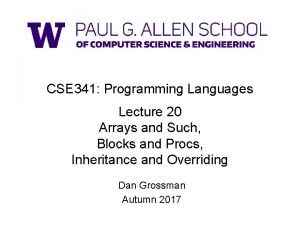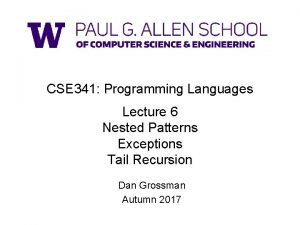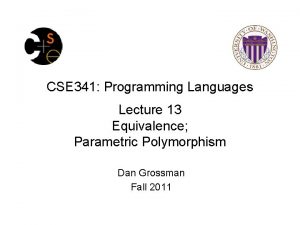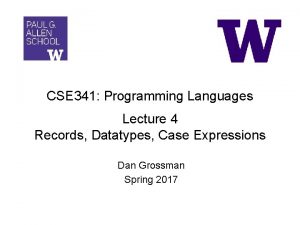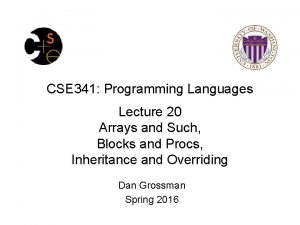CSE 341 Programming Languages Lecture 14 Thunks Laziness


















- Slides: 18

CSE 341: Programming Languages Lecture 14 Thunks, Laziness, Streams, Memoization Brett Wortzman Summer 2019 Slides originally created by Dan Grossman

Delayed evaluation For each language construct, the semantics specifies when subexpressions get evaluated. In ML, Racket, Java, C: – Function arguments are eager (call-by-value) • Evaluated once before calling the function – Conditional branches are not eager It matters: calling factorial-bad never terminates: (define (my-if-bad x y z) (if x y z)) (define (factorial-bad n) (my-if-bad (= n 0) 1 (* n (factorial-bad (- n 1))))) Summer 2019 CSE 341: Programming Languages 2

Thunks delay We know how to delay evaluation: put expression in a function! – Thanks to closures, can use all the same variables later A zero-argument function used to delay evaluation is called a thunk – As a verb: thunk the expression This works (but it is silly to wrap if like this): (define (my-if x y z) (if x (y) (z))) (define (fact n) (my-if (= n 0) (lambda() 1) (lambda() (* n (fact (- n 1)))))) Summer 2019 CSE 341: Programming Languages 3

The key point • Evaluate an expression e to get a result: e • A function that when called, evaluates e and returns result – Zero-argument function for “thunking” (lambda () e) • Evaluate e to some thunk and then call the thunk (e) • Next: Powerful idioms related to delaying evaluation and/or avoided repeated or unnecessary computations – Some idioms also use mutation in encapsulated ways Summer 2019 CSE 341: Programming Languages 4

Avoiding expensive computations Thunks let you skip expensive computations if they are not needed Great if take the true-branch: (define (f th) (if (…) 0 (… (th) …))) But worse if you end up using the thunk more than once: (define (f th) (… (if (…) 0 (… (th) …)))) In general, might not know many times a result is needed Summer 2019 CSE 341: Programming Languages 5

Best of both worlds Assuming some expensive computation has no side effects, ideally we would: – Not compute it until needed – Remember the answer so future uses complete immediately Called lazy evaluation Languages where most constructs, including function arguments, work this way are lazy languages – Haskell Racket predefines support for promises, but we can make our own – Thunks and mutable pairs are enough Summer 2019 CSE 341: Programming Languages 6

Delay and force (define (my-delay th) (mcons #f th)) (define (my-force p) (if (mcar p) (mcdr p) (begin (set-mcar! p #t) (set-mcdr! p ((mcdr p)))) An ADT represented by a mutable pair • #f in car means cdr is unevaluated thunk – Really a one-of type: thunk or result-of-thunk • Ideally hide representation in a module Summer 2019 CSE 341: Programming Languages 7

Using promises (define (f p) (… (if (…) 0 (… (my-force p) …)))) (f (my-delay (lambda () e))) Summer 2019 CSE 341: Programming Languages 8

Lessons From Example See code file for example that does multiplication using a very slow addition helper function • With thunking second argument: – Great if first argument 0 – Okay if first argument 1 – Worse otherwise • With precomputing second argument: – Okay in all cases • With thunk that uses a promise for second argument: – Great if first argument 0 – Okay otherwise Summer 2019 CSE 341: Programming Languages 9

Streams • A stream is an infinite sequence of values – So cannot make a stream by making all the values – Key idea: Use a thunk to delay creating most of the sequence – Just a programming idiom A powerful concept for division of labor: – Stream producer knows how to create any number of values – Stream consumer decides how many values to ask for Some examples of streams you might (not) be familiar with: – User actions (mouse clicks, etc. ) – UNIX pipes: cmd 1 | cmd 2 has cmd 2 “pull” data from cmd 1 – Output values from a sequential feedback circuit Summer 2019 CSE 341: Programming Languages 10

Using streams We will represent streams using pairs and thunks Let a stream be a thunk that when called returns a pair: '(next-answer. next-thunk) So given a stream s, the client can get any number of elements – First: (car (s)) – Second: (car ((cdr (s)))) – Third: (car ((cdr (s)))))) (Usually bind (cdr (s)) to a variable or pass to a recursive function) Summer 2019 CSE 341: Programming Languages 11

Example using streams This function returns how many stream elements it takes to find one for which tester does not return #f – Happens to be written with a tail-recursive helper function (define (number-until stream tester) (letrec ([f (lambda (stream ans) (let ([pr (stream)]) (if (tester (car pr)) ans (f (cdr pr) (+ ans 1)))))]) (f stream 1))) – (stream) generates the pair – So recursively pass (cdr pr), the thunk for the rest of the infinite sequence Summer 2019 CSE 341: Programming Languages 12

Streams Coding up a stream in your program is easy – We will do functional streams using pairs and thunks Let a stream be a thunk that when called returns a pair: '(next-answer. next-thunk) Saw how to use them, now how to make them… – Admittedly mind-bending, but uses what we know Summer 2019 CSE 341: Programming Languages 13

Making streams • How can one thunk create the right next thunk? Recursion! – Make a thunk that produces a pair where cdr is next thunk – A recursive function can return a thunk where recursive call does not happen until thunk is called (define ones (lambda () (cons 1 ones))) (define nats (letrec ([f (lambda (x) (cons x (lambda () (f (+ x 1)))))]) (lambda () (f 1)))) (define powers-of-two (letrec ([f (lambda (x) (cons x (lambda () (f (* x 2)))))]) (lambda () (f 2)))) Summer 2019 CSE 341: Programming Languages 14

Getting it wrong • This uses a variable before it is defined (define ones-really-bad (cons 1 ones-really-bad)) • This goes into an infinite loop making an infinite-length list (define ones-bad (lambda () cons 1 (ones-bad))) (define (ones-bad) (cons 1 (ones-bad))) • This is a stream: thunk that returns a pair with cdr a thunk (define ones (lambda () (cons 1 ones))) (define (ones) (cons 1 ones)) Summer 2019 CSE 341: Programming Languages 15

Memoization • If a function has no side effects and does not read mutable memory, no point in computing it twice for the same arguments – Can keep a cache of previous results – Net win if (1) maintaining cache is cheaper than recomputing and (2) cached results are reused • Similar to promises, but if the function takes arguments, then there are multiple “previous results” • For recursive functions, this memoization can lead to exponentially faster programs – Related to algorithmic technique of dynamic programming Summer 2019 CSE 341: Programming Languages 16

How to do memoization: see example • Need a (mutable) cache that all calls using the cache share – So must be defined outside the function(s) using it • See code for an example with Fibonacci numbers – Good demonstration of the idea because it is short, but, as shown in the code, there also easier less-general ways to make fibonacci efficient – (An association list (list of pairs) is a simple but sub-optimal data structure for a cache; okay for our example) Summer 2019 CSE 341: Programming Languages 17

assoc • Example uses assoc, which is just a library function you could look up in the Racket reference manual: (assoc v lst) takes a list of pairs and locates the first element of lst whose car is equal to v according to isequal? . If such an element exists, the pair (i. e. , an element of lst) is returned. Otherwise, the result is #f. • Returns #f for not found to distinguish from finding a pair with #f in cdr Summer 2019 CSE 341: Programming Languages 18
 Adam doupe cse 340
Adam doupe cse 340 Cse 340 principles of programming languages
Cse 340 principles of programming languages Cse 341
Cse 341 Cse 341
Cse 341 Questions without answers
Questions without answers Stranger thunks
Stranger thunks Laziness
Laziness Laziness
Laziness Learned laziness definition
Learned laziness definition 01:640:244 lecture notes - lecture 15: plat, idah, farad
01:640:244 lecture notes - lecture 15: plat, idah, farad Introduction to programming languages
Introduction to programming languages Cornell programming languages
Cornell programming languages Programming languages
Programming languages Types of programming languages
Types of programming languages Cs 421 programming languages and compilers
Cs 421 programming languages and compilers Cs 421 programming languages and compilers
Cs 421 programming languages and compilers Xkcd programming languages comparison
Xkcd programming languages comparison Advantages and disadvantages of system software
Advantages and disadvantages of system software Joey paquet
Joey paquet












